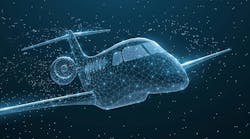Historically, what has the assessment process looked like in A&D manufacturing?
For decades, aerospace and defense companies have been early adopters of advanced technologies such as stealth, composites and computer-aided design. But before automated assessments could be conducted in hybrid cloud environments with high-performance computing capabilities, it was challenging for A&D companies to submit data into a product’s design, maintenance and manufacturing processes autonomously and in real-time, and from all parts of the value chain — including in-service data. Today’s digital technologies ensure product life-cycle data is available in real-time, adaptive and optimized.
Unlike a simple CAD wireframe from the past, which only described the look and shape of an object, a digital twin is a digital model of a physical asset in the real world that uses sensor data associated with the physical device it is replicating. With a digital twin, it’s possible to visualize, test and learn in a simulated environment, enabling rapid “what-if” iterations before embarking on a physical model. It provides rich feedback, enabling researchers and engineers to confidently move through various stages of manufacturing with minimal risk and cost.
What are some challenges associated with the traditional assessment process?
Few A&D manufacturing organizations have only one system managing every application they need for building products and platforms. Normally, A&D manufacturers have an entire range of systems covering enterprise resource planning, product life-cycle management, material requirements planning, enterprise asset management, pipe spools, work orders and more. These systems usually have some level of data exchange and interoperability, but that level can vary significantly.
Furthermore, using different instances of the same application also presents a challenge. For example, a 30-plus-year-old aircraft-manufacturing program may have three distinct phases: design, manufacture, and service. If an organization has a different instance of an application for each phase, often the only form of data exchange that happens occurs during migration from one phase to the next. As a result, data is locked into individual phases instead of being shared freely between applications.
Whether a company is in shipbuilding, aerospace or ground defense, it must understand, organize, classify and connect its data throughout the enterprise, and in particular, its supply chain. Effective data management is key to surviving and thriving in today’s information-rich landscape.
Why are A&D manufacturers ideally suited to benefit from automated assessments?
Although pioneers in manufacturing became early adopters of automated assessments decades ago, recent advancements in artificial intelligence, the internet of things, and high-performance computing are now bringing automated assessments — including digital twins — into mainstream use, particularly in A&D. These technological advancements enable organizations to scale their simulations, shorten deployment timeframes and derive new value.
The internet of things is revolutionizing the product development digital value chain by providing new levels of connectedness and functionality. This change empowers aerospace manufacturers with new ways to develop, innovate and link digital manufacturing and operations due to the endless connections available.
This new industrial internet of things makes it possible to collect data from factories with much less effort and cost than before. On top of that, technologies such as machine learning and AI make it possible to process large amounts of data and gain insights to further predict outcomes and potential issues such as machine failures, component shortages, and quality issues.
How do digital twins support automated assessments?
A digital twin is a digital model of a physical asset that a manufacturer can use to produce real-time visualizations. The manufacturer can put the digital model into different hypothetical scenarios. Through high-performance computing, the organization can see how the asset would perform according to the laws of physics baked into the visualization’s algorithm. In the case of a jet engine airfoil, for example, it would show how much thrust it would produce in real-life circumstances.
Manufacturers can determine whether their products will meet specifications before they are even produced, and they can make changes to correct shortcomings. In fact, the analytics engine can make those adjustments to the connected systems — all without human intervention.
What are some examples of digital twin applications in the assessment process?
Several industries are applying this methodology, highlighting bottlenecks in production and discovering insights that enable them to increase throughput and reduce costs:
- Smart cities. As cities worldwide gear up to become “smart cities,” they are building models of these smart systems in a virtual world to make predictions, pose questions and find solutions through data and analytics. These simulations allow cities to virtually test and learn before deployment. For example, they can understand how autonomous vehicles respond to connected traffic lights to make better and more timely decisions that can improve outcomes, like constituent safety.
- Healthcare. In a value-based care environment, physicians are striving to become increasingly efficient and improve diagnostic accuracy. In an era of precision medicine, digital twins can help doctors provide more individualized treatment and improve patient outcomes. Medical device manufacturers can use digital twins to create and test 3D printed, custom-built orthopedic implants that drastically decrease a patient’s wait time.
- Aerospace and defense. A&D companies frequently leverage digital twins to visualize the status of their products in each step of the production process and in the aftermarket. Digital twins have completely transformed the way some ships and aircraft are designed. By combining digital twins with 3D modeling, for example, shipbuilders can simulate day-to-day tasks and provide critical information for ship design. Similarly, digital twins assess the quality of airfoil blades in jet engines, giving manufacturers a comprehensive process view that includes the amount of thrust produced under real-life circumstances.
How do digital twins factor into digital threads in A&D manufacturing?
A&D manufacturers define digital thread as the integration of all the digital collateral available across different aspects of a given product’s manufacturing process. When viewed this way, digital thread is not a product or piece of software, but an operational concept. In aerospace manufacturing, for example, it’s important to gather, store and keep information current — information about product design, decisions made during the process, component suppliers, how and where the product was manufactured, maintenance logs and basically every aspect of the manufacturing process. Once you establish a digital thread, you can then build out specific examples of a digital twin to perform automated assessments on various parts.
For example, with a digital thread already established, a jet engine manufacturer can take the following steps to build out a digital twin of an airfoil blade to automate the process of inspecting and approving whether it provides the right amount of thrust:
- Define the features and characteristics of the airfoil — the dimension points that reflect its design.
- Connect those features and characteristics with the shop-floor activities — robotics, computerized measuring equipment, and machine tools.
- Measure those changes and bring all the data generated by these systems into a data lake. Every machine, tool and die used in the production process can affect the resulting airfoil’s performance. Changes in machine temperature, the wear on a die or tool — all can have an impact.
- Ensure that the process variables are all under computerized control, to be confident that the right airfoil design is being machined. Once the variables are under control, adjustments can be made for even the slightest changes in the process, whether it is the toolware, the environment or other factors.
- Feed all this information into an analytics system and integrate it with the manufacturing execution system and the material requirements planning system.
The cost to reject an airfoil blade can be as high as $200,000, and there are as many as 80 blades in one engine. Without a digital twin, it can take as long as two weeks to manually calculate whether a change in blade geometry would affect thrust. One jet engine manufacturer has saved tens of millions of dollars through this technology and resolved 80% of manufacturing issues automatically. The manufacturer can now build engines more quickly to meet demand.
Respondent: John Rassieur, Managing Partner, Digital Manufacturing Transformation, Americas Consulting, DXC Technology















